 This is a coupe with the Grand Express shower.Do you know how a branded train differs from a regular one?
This is a coupe with the Grand Express shower.Do you know how a branded train differs from a regular one? The fact that he has a pillow should weigh at least 2 kilograms. The pillow is heavy and sturdy - it means that it’s firm. Light and small - non-firm. Just kidding, of course, now this standard has long been outdated and does not apply.
In fact, RZD has “minimum system requirements” and recommended ones. The minimum is when the car is heated, windows can open and close more than once, and the toilet is sometimes available. Recommended - for example, new cars (up to 12 years old), special training of conductors, good clothes, a large menu of a dining car, a press on board, air conditioning, toilets with liquid soap and seat linings, monitoring of car subsystems. If the train meets all of the recommended requirements of the standard, then it is called firm. And often give him a name.
And still trains can differ devilishly by different things.
Why are they different?
Trains and cars belong to different carriers and have different depot, different services, different types of service. In general, they are different. Somewhere there are dry closets, somewhere there is good underwear, somewhere in each compartment there is an individual air conditioner, somewhere the chests under the lower shelves are not removed (they are removed to make it easier to wash the reserved seats). And so on.
In branded trains, the top places (except lateral ones) are covered with linen. And the corporate train is given the best schedule possible - for example, leaving Moscow late in the evening and arriving in St. Petersburg to discover the metro. An inferior may arrive one hour before the opening of the subway or at lunchtime when most passengers are uncomfortable The company train goes to the station of departure as early as possible, usually at least half an hour before departure. The usual in the region can come in 10 minutes, everyone will sit in a hurry - and he will go.
And, of course, the corporate train gets the right to the name. For example, "Red Arrow", "Sapsan" or "Leo Tolstoy." Megapolis, one of the best trains between Moscow and St. Petersburg, was for a long time non-firm, but met all the standards of the firm.
What do passengers like and dislike?

Most of all passengers like when the conductor is for them. There are trains with very old carriages blowing through the windows by the wind, other pleasures of life - but if the conductor is kind, they always emphasize this. It often happens that they rightly write in a review: everything is bad, but the conductor is mi-mi-mi.
Then the passengers love when they have respected basic household needs. In winter, the train should be warm (but not hot!), The water should be clear, in the summer it should be cool, and the toilet should be clean and not very scary.
Many passengers have a strong love for reserved seats. Many believe that in a fully open car, where you can see and hear for 5–10 meters in both directions, it is somehow safer than to lock in a compartment with three strangers.
What else is pleasant in the train? Sometimes tea is turned on, power is sometimes turned on (sometimes even three meals a day), sometimes slippers, soap-shampoo and toothpaste with a brush are provided, there are TV sets, convenient sockets right in the compartment near the window, sometimes newspapers and magazines are provided, there are safes in the compartment at beds, wardrobes. Very happy passengers coupe that open and close the door with a plastic card. In the reserved seat like individual lamps, like when the car smells like a new one, like Wi-Fi. Anxiously evaluated the quality of towels. If there are machines with food - the choice is in them.
In long-distance trains with a few days on the road, a shower is especially appreciated. The worst option is a basin and a special hose for a crane (this was the way out of the situation on trains with long routes and where there was no place to wash). But it can be quite modern, almost cosmic. In the luxury coupe (where one or two places) is often a shower on the spot and you can wash for your pleasure.
Here are examples of reviews for a particular train, it is immediately clear from them what could go wrong:

Or here:
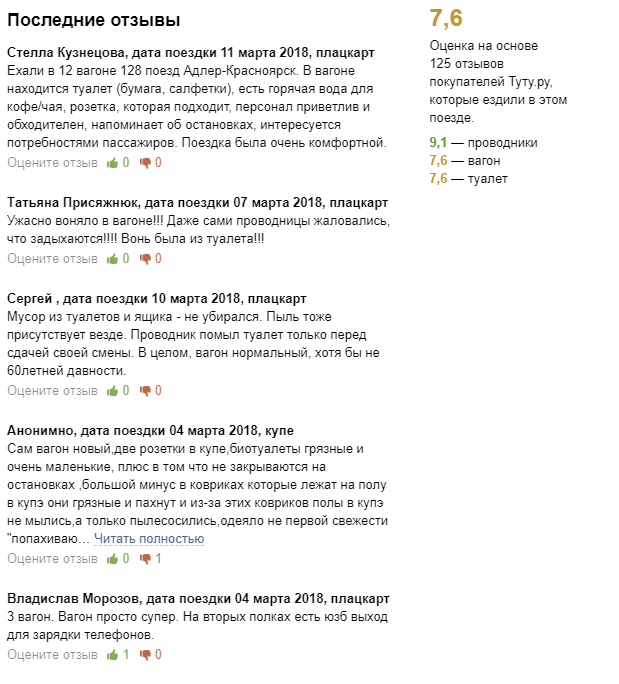
And this is how we derive what is in the car. See, this is a classic corporate train:
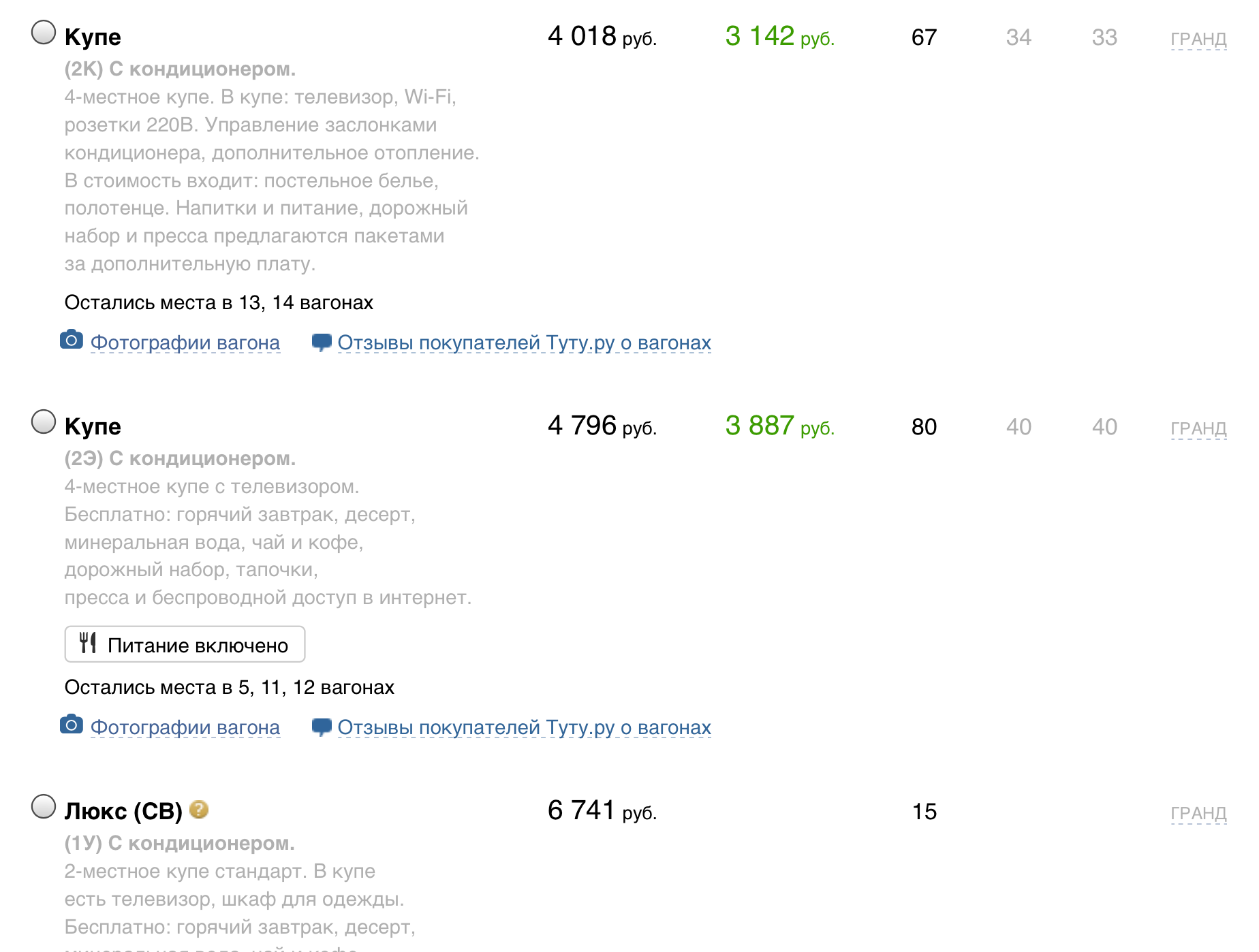
Who are the carriers?
Simplified - the owners of cars, that is, companies that provide services for the delivery of passengers. They are the ones who make sure that the train is good.
In Russia, one large carrier on long-distance passenger trains is the Federal Passenger Company (if you consider it Russian Railways, you will not be mistaken). Plus a lot of private carriers: a relatively large TKS or, for example, Grand Express is the only train of the carrier Grand Service Express. Plus, trains from neighboring countries come to the territory of Russia (most often we come across Ukrainian and Belarusian analogues of our FPC), plus single trains from other countries.
Each carrier has its own characteristics, and each train also. Private carriers are trying to increase the impression of the train, so they are very invested in the fact that it was cool. They have a really great premium with a shower in a compartment, for example.
The only point is that the TKS does not own the bunk (there are no “locomotives”, that is, tractors), so they hook their cars into other trains. But most of the class wagons are about the same.
Here, pay attention to the fourth review - the passenger clearly felt the contrast between the usual cars and brand:
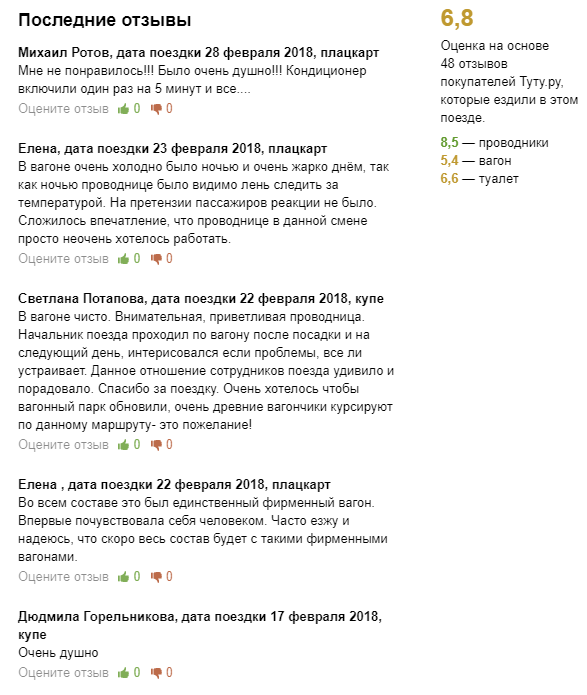
We conduct ratings of each train in Russia and collect feedback on them. This means that on Tutu.ru you can see in detail which features of which train. Of course, if there is only one train in the direction, this will change little in choice. But if at least two, then you will know exactly how they differ. It looks like this:
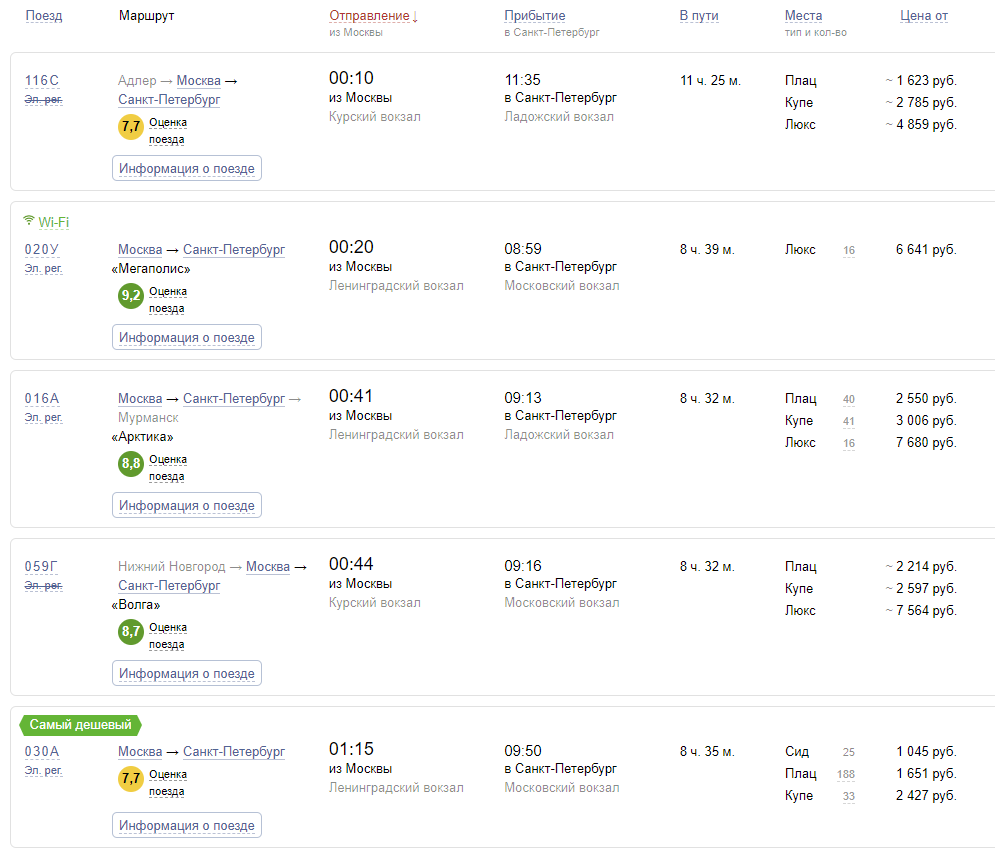
There are a little more than a thousand routes in Russia (plus there are about a hundred for foreign trains), and we derive a rating for the most popular 320 - the rest do not have enough statistically significant reviews. So, for example, if someone offended a whole football team and they wrote the same reviews - this is not at all the same as a few dozen reviews from different passengers in two months.
We accept reviews that are absolutely reliable - you need to buy a ticket and pay it off (that is, to travel in fact on the train) in order to be able to evaluate the car.
What else is different train?
For example, a shower. A shower can be in every luxury compartment (if you travel in a premium train at a high price), or in a staff carriage one for the whole train. In almost any long-distance train, you can quite officially buy the shower service in the headquarters car. The passenger can find out from the conductor where it is a miracle of technology, come to the right car, stand in a queue and pay for the use. Usually, if you don’t run around the reserved seats and don’t shout “THERE IS A SOUL!”, There will be no queues, and the prices there are quite earthly - about 100–200 rubles.
You can also ask the conductor to make a place - and he will make it. Priority for the disabled, the elderly, pregnant women and passengers with children. Considering that they do it like real masters - quickly and quietly - the service is extremely convenient for those who “fit” at an intermediate station into a sleeping car so as not to wake their neighbors.
There are gender coupe. These are where the first passenger in the compartment assigns him a gender sign. That is, if you are a boy and bought a ticket first in the compartment, then a) you will definitely have three more boys later, b) or you can allow passengers of either sex to sit next to you. And four girls can go alongside in the next compartment, because there the first girl bought the ticket. Here, for example,
here is class 1U - just a gender compartment: the first passenger chooses whether this compartment will be only his gender or mixed.
Where did the gender coupe come from? Even when the king was so accepted for decency. And in 2007, this story was restarted (judging by press releases), because so far many girls prefer to go in the company of other girls. It is believed that it is safer. And sober, maybe.
Why do you need a conductor?
For order. Formally - he meets at the entrance, checks the tickets, lets the mourners leave, sees the mourners off, checks the tickets again. He can pour tea (most often for money), sell and make bed linen (you can buy underwear online, or you can buy on the spot), he has cookies, the press, he can help with something. If something is broken, it does not work - it will help. Recently, they still play the role of technical support due to the proliferation of Wi-Fi in cars. Board games can be issued if they are. If the power is on - ask when to apply and what exactly (if there is a choice). And the conductor must wake the passenger "by the leg" so that he will go out at his station. When a passenger misses the station - this is a flaw in the conductor. In this case, the domestic conductor does not have the right to check the same visas, so you can take the train to the Schengen zone without Schengen, but the border guards will drop you off.
What is the difference between trains on short journeys?
There is a long-distance train, there is a local train with the provision of seats and there is a train. Oddly enough, the train is sometimes without electricity (for example, a rail bus). The meaning of these three classes is this:
- A long-distance train has tickets with reinforcement of seats, and most often there are cars of different classes there, sleeping places are very common (for example, in the Sapsan - not, but it is a long-distance train). Tickets go on sale for 45, 60 or 90 (more often) days. Entrance from the platform, that is, do not need a turnstile. Often there is an electronic registration, just show the barcode from the phone or just documents.
- Suburban train with the provision of seats is a cross between a train and a long-distance train. That is, he goes near, but he does it very seriously. Tickets are on sale usually 10 days before departure, conductors in the cars. There are luxury seats, and there are cars like in regular electric trains, but only you have a seat. Service class is often higher than the train.
- Trains (commuter train) are almost always sedentary cars without providing seats. That is, in fact - sit-upright, especially in popular areas. Tickets must be bought shortly before the trip (the exception is different travel cards), you must have a ticket with you to go through the turnstile. There are a lot of interesting things about them, perhaps, my colleagues will tell you later.
- And there is also a hybrid train. This is when one train can be bought as a commuter ticket with the provision of seats, and both on the train, that is, without a seat. For example, there is a train Vladimir - Moscow, in which you can buy a ticket using two schemes, but only from the intermediate Zheleznodorozhnaya station.
What is the difference between a fast train and a speed train?
An ordinary train travels in such a way as to collect all passengers from all villages along the road. His task is transport accessibility. A quick stop is far from everywhere, but only in the main points, it is usually a bit more expensive, but it goes 15 percent faster (depending on the route, of course). Speed - this is the one that shows the average route speed from 91 kilometers per hour. High-speed is the one that does “vzhuh!” (For example, “Sapsan”), its route speed is still from 91 km / h, but at the same time the maximum travel speed is at least 200 kilometers per hour.
It is very easy to distinguish the train by numbering. Even even goes on the map up and to the right, odd number - down and to the left (most often).
1–150 - year-round fast, 151–298 - seasonal and one-time fast, 301–450 - usual year-round, 601–698 - passenger in local traffic, between them - usual seasonal and children's (children’s crawling at speeds up to 50 kilometers per hour) . 701–750 - high-speed, 751–788 - high-speed. 921–940 - tourist (commercial). 961–970 - cargo and cargo. Suburban are numbered from 6001 to 7598 and also have different speeds. The rest of the rare things like postal baggage trains can be found
here .
And there are also regular and temporary trains, they differ in that temporary ones are for the high season, for example, when there are a lot of people going from Sochi to Moscow. There are trains for tourists - for example, they will launch a football championship. They are introduced according to the situation in order to satisfy the demand for the direction. There are also regular trains that run weekly in a year — for example, when the FPC knows that at that time the week of the railways will definitely come and the train population will double. On New Year's Eve, such options are often found, and they appear in the schedule long before departure.
Let's look at the ratings already!
Here are the first thirty trains to date:
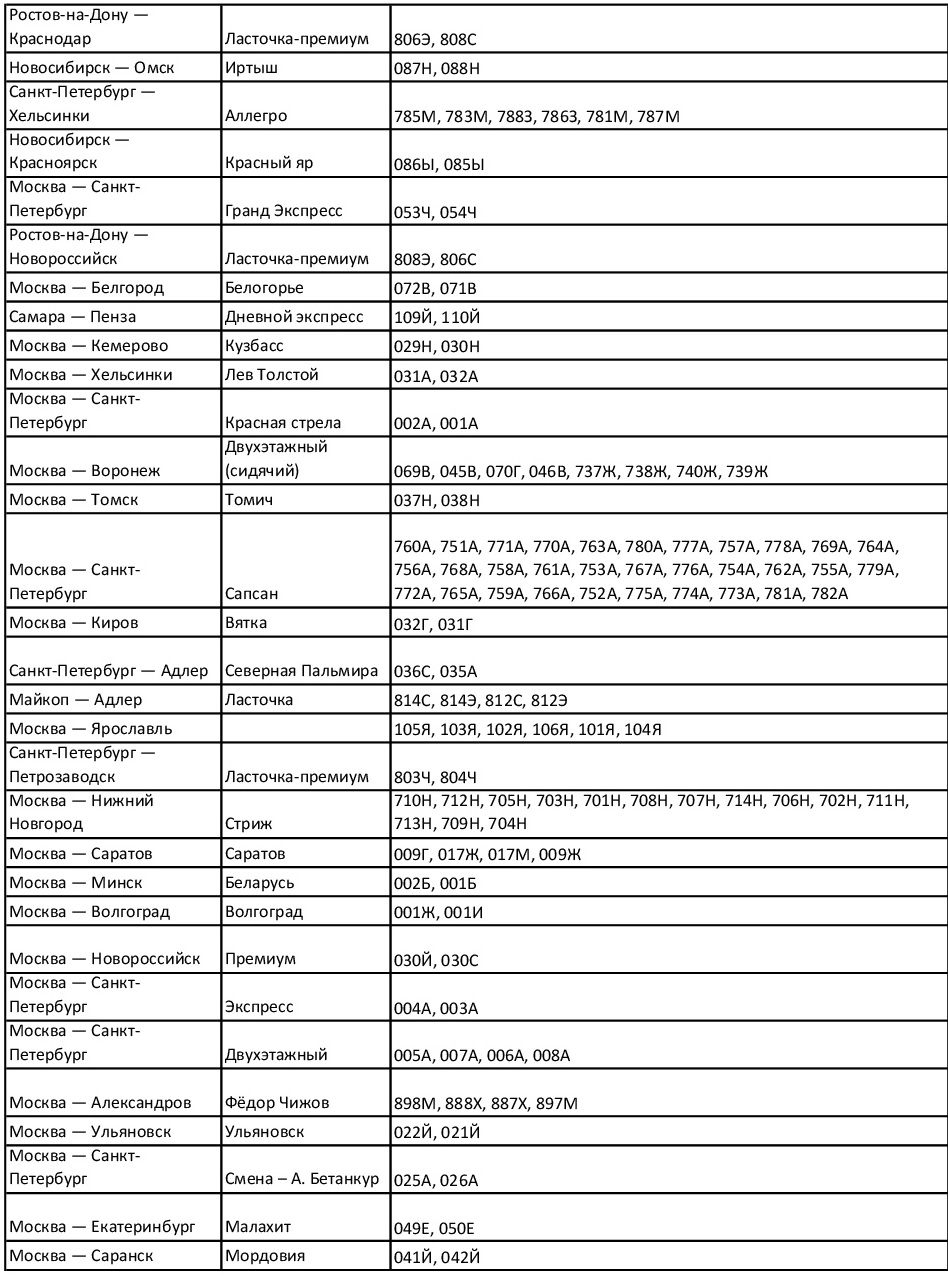
It is believed that the farther from the capital, the worse the train. So, this is not true: the distribution is fairly uniform within Russia. There is no clear correlation between the directions where one or two trains go and where there is a lot of competition - perhaps this means that the trains on them compete not with each other, but with airplanes and buses.
Every six months we upload an extended version of analytics to carriers, and they give us photos of cars (we also enrich the data with photographs obtained independently). When buying a ticket for many trains in Russia, when choosing a place, you can see a photo of your type of compartment in the selected car, for example, like this:
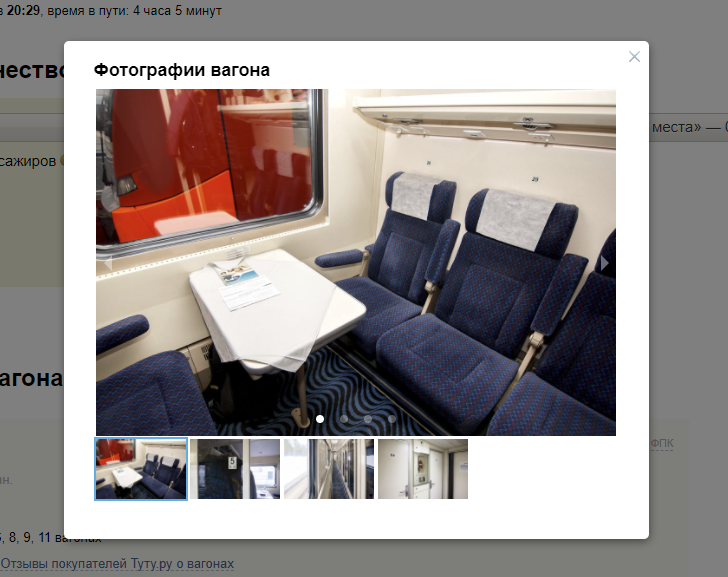
And yes, we know that carriers carefully monitor the ratings we collect, look at the reviews and take action. The most important thing - then you can numerically track the result.
And Tverskoy Carriage Works (he is not a carrier, they do cars) asked to unload reviews on the types of their cars: very carefully read what people do not like and like, and put it into new models that they plan to produce.